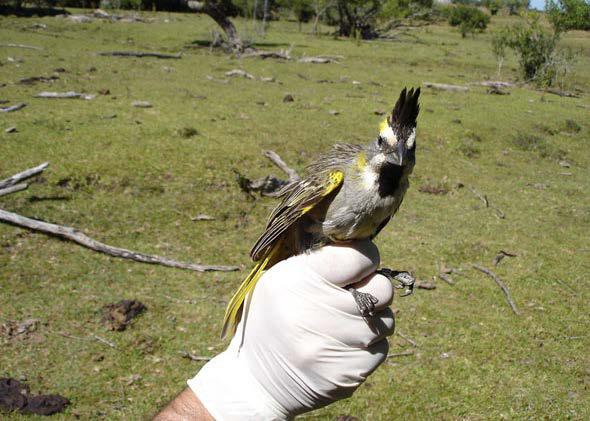Gabriel Rocha Sagrera
Other projects
5 Jan 2012
Yellow Cardinal (Gubernatix cristata) and other Threatened Grassland Birds Conservation in Uruguay
The main objective of this project is to provide long-term, effective conservation of one important grassland area in Paysandú, through the involvement of the local community.

Yellow Cardinal (Gubernatrix cristata) Endangered
A.C.U.O. is a NGO of Republic of Uruguay and has been working since 1998 in conservation birds and habitat. The main objective of this project is to provide long-term, effective conservation of one important grassland area in Paysandú, through the involvement of the local community. This area is very important for conservation of fauna and flora, specially for birds. The species threatened are: White-collared Seedeater (Sporophila zelichi), Marsh Seedeater (Sporophila palustris), Yellow Cardinal (Gubernatrix cristata), Black-and-white Monjita (Xolmis dominicana), Chestnut Seedeater (Sporophila cinnamomea), Sharp-tailed Grass-tyrant (Culicivora caudacuta), Saffron-cowled Blackbird (Xanthopsar flavus) and near threatened: Greater Rhea (Rhea americana), Dark-throated Seedeater (Sporophila ruficollis), Rufous-rumped Seedeater (Sporophila hypochroma) and Bearded Tachuri (Polystictus pectoralis).
During the last two decades, land uses in grassland habitats is switching to intensive-use agriculture with high inputs of pesticides, and aforestation, which replace original grassland habitat and transform the landscape. These areas that we considering very important for protection birds and other species and are mainly located within privately-owned properties. An adequate conservation strategy must be adopted, and work must be closely tied with local landowner interests, as well as other local entities. In addition, the local Departmental Governments have shown interest in conserving natural habitats within their areas of influence, and the Ministry of Tourism has a special interest in supporting local bird-watching activities.
The project research on the effect of grassland quality, fragment size and landscape variables on the presence and abundance of grassland-dependent and threatened species. Also establishment of a regional grasslands bird monitoring program. The activities will include intensive (habitat and site-specific) and extensive (roadside) censuses carried out at least twice a year, to monitor bird populations and adapt regional conservation strategies to the programs results. Local bird guides will be trained to carry out these surveys. Teach at least one class on birds and conservation in each of the primary schools of the region, and organize fields trips with the children and their teachers and to make educational materials.